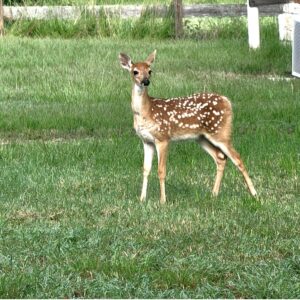 I am suffering from fawn anthropomorphism. I didn’t know what that term meant until I searched for “attributing human emotions to animals” on the internet. According to PsychCentral, projecting human-like qualities onto objects is commonly how we view and interact with our environment.
I am suffering from fawn anthropomorphism. I didn’t know what that term meant until I searched for “attributing human emotions to animals” on the internet. According to PsychCentral, projecting human-like qualities onto objects is commonly how we view and interact with our environment.
Anthropomorphism is baked into our DNA. Our society reflects this by giving Micky Mouse and Donald Duck human characteristics and assigning human names to tropical storms. All cultures and societies do this. Hello Kitty, a Sanrio character conceived in Japan, is another example. Her official character profile lists her full name as Kitty White, born in the suburbs of London. She even has a twin sister! Playing the piano, baking cookies, and collecting cute things are her hobbies. WHO KNEW?
THE FAWN APPEARS
Back to my obsession. I live in a rural setting and native white-tailed deer are common. Rutting season starts in early September and ends in December. The first babies appear six and a half to seven months later. They do not migrate, spending their lives in an area of around 250 acres. Typical behavior for deer is to freeze when they sense trouble, hoping you will not notice them. If that is unsuccessful, they take off, holding their tails high, the white underside showing.
White-tailed fawns have a tan coat with white spots, allowing them to lie in the grass, undetected. Typically, the mother parks her baby and goes foraging for food, usually for hours at a time. If you approach a fawn and the mother is around, she will take off, trying to distract you.
A doe has, in the past, kept her baby on the west side of the fence around the house. This year was no different.
For the sake of the story, I will call the fawn in question “Baby.” I have no idea the sex, so I will use the recommended pronoun “they” to handle this uncertainty.
THE FAWN’S MOTHER
Unlike in the film, Bambi, where the hunter kills Bambi’s mother, Baby’s was a victim of vehicular homicide. About a month ago I came home to a doe carcass several hundred feet down the road from my driveway. Soon Baby appeared in my yard with increasing frequency. Only then did I put two and two together, realizing its mother was the unfortunate victim.
WILDLIFE EXPERTS’ ADVICE REGARDING THE FAWN
Experts recommend leaving the fawn alone because, most often, the mother returns. If the fawn is walking around, appears dehydrated, and is crying, you are to call state wildlife authorities. But Baby was in none of these categories.
MY FAWN OBSESSION BEGINS
After first encountering Baby, I became increasingly agitated as the frequency of our meetings increased. Should I stare? Look away? Scare they away?
I did not want to acclimate Baby to humans as others might harm the fawn. Watching carefully, relief flooded through me when I observed Baby grazing. At least they was acquiring some nutrition. My hope was that Baby’s aunts and cousins would come to the rescue.
After a month, however, hysteria set in. Baby was still here. Thoughts ruminated about how they must feel, losing a mother, and being abandoned by family. My worry had now turned into an obsession. After calling a friend who is knowledgeable about white-tails, I scattered deer feed in the yard to provide extra nourishment.
Despite not having seen Baby for two days, I continually peer out my window, scanning the yard for the fawn.
Early this morning I took out the trash, only to see a white-tail mom and older doe in the general vicinity of Baby’s resting area. Has Baby been rescued? Oh, no. Now I fear my preoccupation will continue. Has Baby joined family or met a fate like Mom’s?
FINAL FAWN THOUGHTS
My obsession is bad enough, but now I am flailing myself for becoming obsessed and transferring human traits to the animal, increasing my stress level. Oh, by the way, my grandson found the skull of Baby’s mother and deposited it in the back of my Gator, leaving me a lasting reminder of Mom’s death. The result? Fixation on how she must have felt as the human-run contraption wiped her off the face of the earth.
Do you suffer from debilitating anthropomorphism?
Sign up on www.mariewatts.com to receive future Stories About Life delivered to your email address or read more stories by clicking here.

Recent Comments